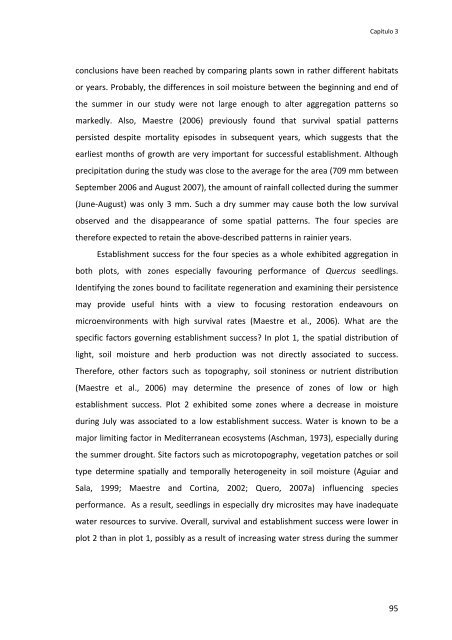Establecimiento de cuatro especies de Quercus en el sur de la ...
Establecimiento de cuatro especies de Quercus en el sur de la ...
Establecimiento de cuatro especies de Quercus en el sur de la ...
You also want an ePaper? Increase the reach of your titles
YUMPU automatically turns print PDFs into web optimized ePapers that Google loves.
Capítulo 3<br />
conclusions have be<strong>en</strong> reached by comparing p<strong>la</strong>nts sown in rather differ<strong>en</strong>t habitats<br />
or years. Probably, the differ<strong>en</strong>ces in soil moisture betwe<strong>en</strong> the beginning and <strong>en</strong>d of<br />
the summer in our study were not <strong>la</strong>rge <strong>en</strong>ough to alter aggregation patterns so<br />
markedly. Also, Maestre (2006) previously found that <strong>sur</strong>vival spatial patterns<br />
persisted <strong>de</strong>spite mortality episo<strong>de</strong>s in subsequ<strong>en</strong>t years, which suggests that the<br />
earliest months of growth are very important for successful establishm<strong>en</strong>t. Although<br />
precipitation during the study was close to the average for the area (709 mm betwe<strong>en</strong><br />
September 2006 and August 2007), the amount of rainfall collected during the summer<br />
(June‐August) was only 3 mm. Such a dry summer may cause both the low <strong>sur</strong>vival<br />
observed and the disappearance of some spatial patterns. The four species are<br />
therefore expected to retain the above‐<strong>de</strong>scribed patterns in rainier years.<br />
Establishm<strong>en</strong>t success for the four species as a whole exhibited aggregation in<br />
both plots, with zones especially favouring performance of <strong>Quercus</strong> seedlings.<br />
I<strong>de</strong>ntifying the zones bound to facilitate reg<strong>en</strong>eration and examining their persist<strong>en</strong>ce<br />
may provi<strong>de</strong> useful hints with a view to focusing restoration <strong>en</strong><strong>de</strong>avours on<br />
micro<strong>en</strong>vironm<strong>en</strong>ts with high <strong>sur</strong>vival rates (Maestre et al., 2006). What are the<br />
specific factors governing establishm<strong>en</strong>t success? In plot 1, the spatial distribution of<br />
light, soil moisture and herb production was not directly associated to success.<br />
Therefore, other factors such as topography, soil stoniness or nutri<strong>en</strong>t distribution<br />
(Maestre et al., 2006) may <strong>de</strong>termine the pres<strong>en</strong>ce of zones of low or high<br />
establishm<strong>en</strong>t success. Plot 2 exhibited some zones where a <strong>de</strong>crease in moisture<br />
during July was associated to a low establishm<strong>en</strong>t success. Water is known to be a<br />
major limiting factor in Mediterranean ecosystems (Aschman, 1973), especially during<br />
the summer drought. Site factors such as microtopography, vegetation patches or soil<br />
type <strong>de</strong>termine spatially and temporally heterog<strong>en</strong>eity in soil moisture (Aguiar and<br />
Sa<strong>la</strong>, 1999; Maestre and Cortina, 2002; Quero, 2007a) influ<strong>en</strong>cing species<br />
performance. As a result, seedlings in especially dry microsites may have ina<strong>de</strong>quate<br />
water resources to <strong>sur</strong>vive. Overall, <strong>sur</strong>vival and establishm<strong>en</strong>t success were lower in<br />
plot 2 than in plot 1, possibly as a result of increasing water stress during the summer<br />
95

















